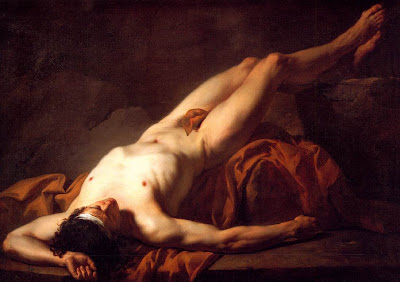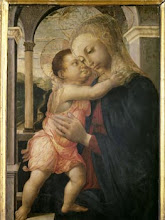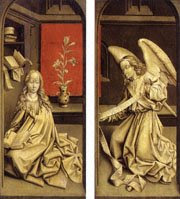sabato
:: David, Jacques Louis...




DAVID, Jacques-Louis
(b. 1748, Paris, d. 1825, Bruxelles)
Biography
French painter, one of the central figures of Neoclassicism. He had his first training with Boucher, a distant relative, but Boucher realized that their temperaments were opposed and sent David to Vien. David went to Italy with the latter in 1776, Vien having been appointed director of the French Academy at Rome, David having won the Prix de Rome. In Italy David was able to indulge his bent for the antique and came into contact with the initiators of the new classical revival, including Gavin Hamilton. In 1780 he returned to Paris, and in the 1780s his position was firmly established as the embodiment of the social and moral reaction from the frivolity of the Rococo. His uncompromising subordination of colour to drawing and his economy of statement were in keeping with the new severity of taste. His themes gave expression to the new cult of the civic virtues of stoical self-sacrifice, devotion to duty, honesty, and austerity. Seldom have paintings so completely typified the sentiment of an age as David's The Oath of the Horatii (Louvre, Paris, 1784), Brutus and his Dead Sons (Louvre, 1789), and The Death of Socrates (Metropolitan Museum, New York, 1787). They were received with acclamation by critics and public alike. Reynolds compared the Socrates with Michelangelo's Sistine Ceiling and Raphael's Stanze, and after ten visits to the Salon described it as 'in every sense perfect'.
David was in active sympathy with the Revolution; he served on various committees and voted for the execution of Louis XVI. His position was unchallenged as the painter of the Revolution. His three paintings of 'martyrs of the Revolution', though conceived as portraits, raised portraiture into the domain of universal tragedy. They were: The Death of Lepeletier (now known only from an engraving), The Death of Marat (Musées Royaux, Brussels, 1793), and The Death of Bora (Musée Calvet, Avignon, unfinished). After the fall of his friend Robespierre (1794), however, he was imprisoned, but was released on the plea of his wife, who had previously divorced him because of his Revolutionary sympathies (she was a royalist). They were remarried in 1796, and David's Intervention of the Sabine Women (Louvre, 1794-99), begun while he was in prison, is said to have been painted to honour her, its theme being one of love prevailing over conflict. It was also interpreted at the time, however, as a plea for conciliation in the civil strife that France suffered after the Revolution and it was the work that re-established David's fortunes and brought him to the attention of Napoleon, who appointed him his official painter.
David became an ardent supporter of Napoleon and retained under him the dominant social and artistic position which he had previously held. Between 1802 and 1807 he painted a series of pictures glorifying the exploits of the Emperor, among them the enormous Consecration of the Emperor Napoleon I and Coronation of the Empress Josephine (Louvre, 1805-07). These works show a change both in technique and in feeling from the earlier Republican works. The cold colours and severe composition of the heroic paintings gave place to a new feeling for pageantry which had something in common with Romantic painting, although he always remained opposed to the Romantic school. With the fall of Napoleon, David went into exile in Brussels, and his work weakened as the possibility of exerting a moral and social influence receded. (Until recently his late history paintings were generally scorned by critics, but their sensuous qualities are now winning them a more appreciative audience.) He continued to be an outstanding portraitist, but he never surpassed such earlier achievements as the great Napoleon Crossing the Alps (Kunsthistorisches Museum, Vienna, 1800, one of four versions) or the coolly erotic Madame Récamier (Louvre, 1800). His work had a resounding influence on the development of French - and indeed European - painting, and his many pupils included Gérard, Gros, and Ingres.
Iscriviti a:
Commenti (Atom)








































.jpg)


.jpg)











